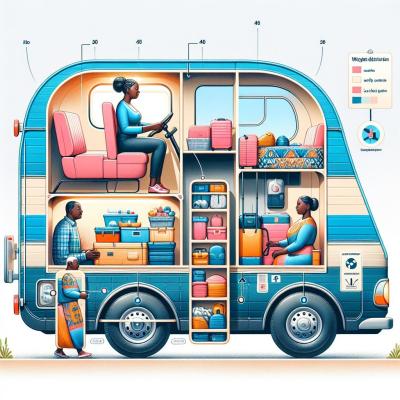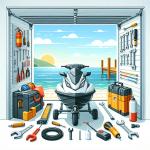Why does this matter? Proper weight distribution directly affects the handling of your towing setup. It impacts stability, braking efficiency, and steering responsiveness, all of which are pivotal for your safety on the road. An imbalance can lead to sway, reduced traction, and even loss of control in severe cases. Therefore, mastering the art of weight distribution is as necessary as any other aspect of driving.
Throughout this article, we'll delve into best practices and strategies for optimal weight distribution. You'll learn about correct load placement, the use of specialized equipment, and other tips that contribute to a secure and enjoyable caravan experience. Whether you're a seasoned caravanner or gearing up for your first adventure, this guide will ensure that you hit the road with confidence.
Understanding Caravan Weight Terms
Explanation of Tare, ATM, GVM, and GTM
Before altering any part of your caravan's load, it's essential to familiarize yourself with common weight terminology. 'Tare' refers to the unladen weight of the caravan as it leaves the manufacturer, without additional luggage or equipment. 'ATM', or Aggregate Trailer Mass, is the combined weight of the caravan itself when it's fully loaded and ready for the road – it must not exceed the manufacturer's specified limit.
Moving on to the towing vehicle, 'GVM' stands for Gross Vehicle Mass – the maximum allowable weight of the vehicle when fully loaded, including passengers, fuel, and the caravan's tow ball weight. Next in line, 'GTM' or Gross Trailer Mass, denotes the weight that can be supported by the caravan's wheels when coupled to the tow vehicle. The GTM will always be less than the ATM due to the tow ball weight applied to the tow vehicle.
The Relevance of Tow Ball Weight
The tow ball weight is a critical factor; it's the downward force that the caravan exerts on the tow ball of the vehicle. It's vital for caravan stability – too light, and you risk caravan sway; too heavy, and you could compromise steering or even damage your vehicle's suspension. An ideal tow ball weight is usually between 8% and 15% of your caravan's ATM. Keeping within this range provides a balance that enhances stability during towing.
How Weight Affects the Caravan's Balance
A caravan's weight must be balanced both longitudinally and laterally. This means distributing weight evenly from front to back and side to side. Having too much weight at either end or one side can seriously affect the caravan's balance and handling. The center of gravity should be low and centered over the axles for optimal stability. Understanding and monitoring these terms and weight distributions before and during your trip will go a long way in safeguarding your journey and offering peace of mind as you navigate different terrains.
The Consequences of Poor Weight Distribution
Reduced Vehicle Control and Increased Stopping Distances
Imbalanced weight distribution in a caravan can significantly undermine your control over the vehicle. When the load is not well-distributed, especially with excess weight at the rear, the towing vehicle may suffer from a reduction in front axle weight, leading to compromised steering precision. This issue can make it challenging to maneuver the vehicle, particularly in emergency situations or when navigating corners.
This imbalance also impacts the effectiveness of your braking system. With more weight to halt, stopping distances can markedly increase, putting you at a higher risk of accidents. The added strain on the brakes might lead to premature wear and even brake failure if not properly managed.
Potential for Caravan Sway and Accidents
Caravan sway is one of the most perilous consequences of poor weight distribution. This phenomenon occurs when the caravan begins to oscillate from side to side, potentially escalating to uncontrollable levels. Many factors can induce sway, like high winds, passing vehicles, and uneven road surfaces. However, if the caravan's load is not properly centered and distributed, sway can become much more likely and violent, increasing the potential for accidents and rollovers.
Uneven Tire Wear and Potential Blowouts
Another critical issue associated with incorrect weight distribution is uneven tire wear. When the caravan's weight is not evenly allocated, certain tires may bear more weight than they are designed to handle, leading to accelerated wear and increased risk of blowouts. Blowouts not only require inconvenient repairs but they also pose serious safety risks, potentially causing loss of control or accidents.
Regularly rotating your tires and maintaining proper tire pressure can help mitigate these risks, but the most effective measure is ensuring the caravan is correctly packed and that weight is evenly distributed from the get-go. Proper weight distribution is thus not only essential for smooth handling and longevity of your caravan but it's also a vital safety precaution every caravanner needs to implement for a trouble-free journey.
Key Factors Influencing Weight Distribution
The Position of Heavy Items Within the Caravan
One of the most significant factors affecting weight distribution is the placement of heavy items within your caravan. Ideally, these items should be placed low to the ground and as close to the axle as possible. This strategy helps maintain a low center of gravity and equitably distributes the weight across the axles, which is crucial for stability. It's also important to spread the weight evenly from side to side to prevent the caravan from listing or becoming unstable on the road.
When loading your caravan, think of it as a scale that needs balancing. The aim is to prevent the front or back from being too heavy, which can impact the tow vehicle's ability to control the caravan. Appliances like fridges and battery packs, which tend to be heavy, should be secured in the caravan’s midsection to contribute to this balance.
The Impact of Adding Accessories and Modifications
Accessories and modifications can enhance the functionality and comfort of your caravan but can also alter its weight distribution. Adding bike racks, solar panels, extra batteries, or even just a full water tank can have a significant influence on how weight is dispersed within and across your setup. Being mindful of the cumulative weight of these additions and their effect on balance is paramount.
It's recommended that any modifications or additions are carefully planned and placed to maintain equilibrium. For instance, if you install a heavy item on one side, counterbalance it with a similar weight on the opposite side. This counterbalancing reduces stress on the structure and suspension components of the caravan and the tow vehicle.
Adjusting for Changes in Cargo and Passenger Weight
Each trip can be different in terms of passengers, cargo, and equipment, which means weight distribution may need to be reassessed every time you set out. The number of passengers, how cargo is packed, and the equipment brought along all form part of the equation.
Adjust for these changing weights by reassessing the overall distribution and making necessary shifts before starting your journey. This also includes checking for any shifts in cargo during pit stops or while en route to your destination, as movement of items inside can skew the balance over time. Becoming adept at these adjustments can take time, but with experience, it will become a routine part of your departure checklist, ensuring a safer and more enjoyable caravan experience.
The Role of Weight Distribution Systems
What are Weight Distribution Hitches (WDH) and How Do They Work?
Weight distribution hitches (WDH) are an essential tool for anyone towing a heavy trailer or caravan. They are designed to evenly distribute the tow load across the caravan's axles and the towing vehicle's front and rear axles. Without a WDH, the caravan's weight could cause the rear of the towing vehicle to sag and the front to lift, compromising steering and braking. A WDH counteracts this by transferring a portion of the caravan's tongue weight through spring bars to the front axle of the towing vehicle and back to the caravan's axles.
The WDH functions by creating a bridge between the caravan and the tow vehicle, which helps in leveling the two. This process alleviates excessive downward force on the hitch and ensures a more level ride, improving steering and braking control. Thus, a well-adjusted WDH is critical for maintaining safety and reliability when you're on the road.
Types of WDHs and Choosing the Right One
There are various types of weight distribution hitches available, and the right one for you will depend on several factors. These include the weight of your caravan, the tow ball weight, and the towing capacity of your vehicle. The most common types of WDHs include round bar, trunnion bar, and the Anderson hitch – each offering different advantages. Round bar hitches are often used for lighter duty, while trunnion bar hitches are more suited for heavier loads with their increased ground clearance and weight distribution.
It is essential to select a WDH that matches the gross trailer weight (GTW) and the maximum tongue weight of your caravan. Consult the manufacturer's recommendations and consider the fully-loaded weight of your caravan to determine the appropriate WDH for your setup. Moreover, consider ease of use, adjustability, and compatibility with your tow vehicle's hitch and the caravan's coupler.
How to Set Up and Adjust a WDH
Setting up and adjusting a weight distribution hitch is a critical step in ensuring a safe towing experience. Initially, the hitch must be properly installed on the towing vehicle, which usually involves bolting the hitch receiver and setting up the shank and ball mount. The spring bars are then connected to the caravan's trailer frame through chains or brackets.
Once attached, the tension on the WDH is adjusted to ensure proper weight distribution. This is often done by lifting the spring bars and adjusting the chain links or brackets to the appropriate level of tension. The goal is to have the caravan and tow vehicle evenly saturated, without any dramatic sagging at the coupling point. It's crucial to review the WDH manufacturer’s guidelines for specific tension settings.
Remember that setting up a WDH can be complex and requires careful attention to detail. It might be beneficial to seek professional assistance the first time. Regular checks and adjustments may also be needed over time as loads change and components settle or wear. Ensuring your WDH is correctly adjusted will contribute significantly to smoother steering, better braking, and an overall safer caravan journey.
Practical Tips for Loading Your Caravan
Guidelines for Loading and Organizing Cargo
When it comes to loading your caravan, starting with a plan is crucial. Begin by laying out all the items you intend to take and categorize them by weight. Heavier objects should be placed over the axle or as close to it as possible, while lighter items can be stored in cabinets higher up and at the ends of the caravan. To prevent movement while traveling, ensure that all cargo is firmly secured, using non-slip mats and straps as necessary.
Organize your items in a way that ensures easy access to what you need at each stop, without having to shift heavy objects around frequently. Kitchen items, clothing, and daily necessities should be in an accessible spot. Use space economically by nesting items together and exploiting hollow items, like pots and coolers, as storage for smaller goods.
Strategies for Maintaining an Even Weight Balance
A balanced caravan not only pulls more efficiently but also increases safety on the road. Distribute weight evenly from side to side, and check the weight by using a caravan scale or public weighbridge. This precaution prevents listing, which can be disruptive to handling. For simulating how the weight will carry while driving, load the caravan with a typical water and fuel setup, as these liquids significantly contribute to the total weight.
Adjust the distribution of your items based on the driving conditions you anticipate. For instance, if you're headed into strong winds or over hilly terrain, ensure your caravan is packed with a slight bias toward the front to reduce the chance of swaying. Still, take care not to exceed the recommended tow ball weight for your vehicle.
Regular Checks and Adjustments During Travel
Conditions change during travel; thus, it's essential to perform regular checks on your load. At each stop, inspect the caravan's contents to ensure that nothing has shifted significantly and rebalance the load as needed. Pay special attention to items in external storage compartments, as these are more prone to movement. Before recommencing travel, verify that all doors, cabinets, and external hatches are securely closed.
Over the course of your trip, take note of how your caravan handles. If you notice changes in maneuverability or an increase in swaying, it may indicate that your load has shifted or settled in a way that is impacting weight distribution. These observations should prompt an immediate load assessment and adjustment to rectify any distribution issues before they compromise your safety.
Regular Maintenance to Ensure Ongoing Safety
Checking and Servicing Caravan Suspension and Brakes
Regular upkeep of your caravan's suspension and brakes is paramount to maintaining safety on your travels. The suspension system endures a lot of stress, especially when traversing uneven surfaces or carrying heavy loads. Inspect the suspension for any signs of wear, such as rust or damaged components, before and after each trip. Servicing it annually—or more frequently if you travel often or over rough terrain—will help to catch potential issues early on.
Similarly, the braking system is vital for the safe stopping of your caravan. Brakes should be checked at regular intervals to ensure all components are in good working condition. Look for worn pads, discs, or drums, and pay attention to any changes in braking performance. If you detect any issues or it's been a while since the last check, have a professional examine and service your brakes to ensure they're operating effectively.
Maintaining Tire Health and Pressures for Safe Towing
Tires are the point of contact between your caravan and the road, and their condition directly affects your journey's safety and smoothness. Always begin by checking the caravan's tire pressures when they are cold, adjusting them according to the manufacturer's recommended levels. Correct pressure is crucial not only for reducing the risk of tire failure but also for optimal grip and weight distribution.
Inspection for cuts, bulges, or irregular wear patterns should be part of your routine maintenance. Consider the age of your tires too; even if they look alright, rubber degrades over time, and old tires can become a hazard. By keeping a regular check on the health of your tires and replacing them as necessary, you're taking an important step towards a safe towing experience.
Scheduled Checks for Hitch Equipment and Coupling Devices
The integrity of your hitch equipment and coupling devices is what keeps your caravan connected to the towing vehicle, so their regular inspection cannot be understated. Check the hitch for any signs of cracks, corrosion, or other damage every time you attach or detach your caravan. Lubricate moving parts according to the manufacturer's specifications to prevent wear and ensure smooth operation.
Coupling devices should be subjected to a similar scrutiny. Make sure locking mechanisms are functioning properly and that there is no excessive play which could indicate wear. If you use a Weight Distribution Hitch, confirm that all components like spring bars and tensioners are intact and correctly adjusted. These scheduled checks are essential chores that contribute greatly to the overall safety of your caravan's towing system.
Advanced Tips and Tricks
Using Advanced Tools and Gauges to Measure Weight Distribution
To achieve precise weight distribution, experienced caravanners often use advanced tools and gauges. Weight distribution scales allow you to measure the exact downforce on each wheel and the hitch. This level of accuracy ensures that the load is distributed evenly across all tires, preventing undue stress and wear. By using these tools before setting off, you can make informed adjustments that enhance stability and safety.
Towing mirrors and rearview cameras are also invaluable. They provide a clear view of the caravan and its behavior while on the move, allowing the driver to detect signs of imbalance such as uneven tire compression or swaying. When employed in conjunction with weight distribution tools, these devices can give you a comprehensive picture of the towing dynamics at play.
Adjustments for Different Road Conditions and Weather Scenarios
Different road conditions and weather can significantly affect caravan stability and handling. For instance, wet or icy roads require a lower center of gravity to maintain traction, which might mean repacking your caravan to lower the weight. Similarly, windy conditions necessitate a more aerodynamic setup with less surface area exposed to crosswinds, potentially adjusting how cargo is stacked inside.
Seasoned travelers often modify tire pressures according to the terrain—lower pressures can provide better grip off-road, while higher pressures are suited for highways. Always reference your tire manufacturer’s specifications when making these adjustments. Being versatile and willing to tweak your setup as conditions change is the hallmark of an advanced caravanner.
Incorporating Feedback from Towing Experiences to Improve Balance
One of the best ways to master weight distribution is to learn from each towing experience. Take note of how your caravan handles different speeds, turns, and braking situations. If you notice any issues—like a particular corner inducing sway or instability during braking—use these observations to adjust your loading strategy for the next trip.
Keeping a log of changes and their effects can be incredibly helpful. Document the position and weight of cargo, the settings on your weight distribution hitch, and any accessory usage (like water tanks or generators). Over time, this log will become a valuable resource, helping you to replicate successful setups and avoid past mistakes, refining your mastery of weight distribution for a truly smooth and safe caravan journey.
Common Mistakes to Avoid and How to Correct Them
One common mistake caravanners make is not considering the cumulative effect of small items. When many small, seemingly insignificant items collect at one end of the caravan, they can create a significant weight bias. Regularly reviewing and reassessing all stored items, even the minor ones, can prevent this oversight. Periodically weighing your caravan at a weighbridge can confirm your load's distribution and help you make necessary adjustments.
Overloading the caravan is another frequent error. Every caravan has a payload limit, and exceeding this can lead to tire blowouts, brake failure, and suspension damage. To prevent these issues, scrutinize every item you pack, prioritize necessities, and be aware of your caravan's weight capacity. Always pack with a 'less is more' philosophy, particularly for short trips where amenities will be readily available.
These case studies highlight the importance of continuous learning and adjustment when it comes to caravan weight distribution. By taking heed of real-world examples and staying vigilant about loading correctly, caravanners can avoid common mistakes, ensuring a smooth and safe journey every time they hit the road.
Mastering the Art of Caravan Packing
As we've explored in this guide, the mastery of weight distribution within a caravan is not just desirable—it's essential for a safe and serene journey. From understanding the critical weight terms like ATM and GVM to implementing practical tips for loading your caravan, we've covered a broad spectrum of strategies to ensure your caravan is as stable and as secure as possible.
We have delved into the importance of weight distribution systems, such as the proper use of weight distribution hitches (WDH), and discussed the significant role of regular maintenance in the long-term safety of your caravan travel. Advanced tools and gauges for measuring precise weight distribution have also been highlighted, illustrating the depth to which one can go to ensure every trip is as smooth as possible.
Mastery in anything requires practice, and caravan packing is no exception. Continually refining your approach after each trip, incorporating the feedback from different towing experiences, is key to improving your skills. It's a process of learning, adapting, and, most importantly, enjoying the sense of security that comes from knowing you have done your utmost to ensure a safe journey for you, your passengers, and fellow travelers on the road.
We encourage you, the caravan community, to share your experiences and tips with one another. Your anecdotes and advice not only enrich this discussion but can also provide that crucial nugget of wisdom that may help another caravanner avoid common pitfalls. If you have a particular insight or a story of a lesson learned on the roads, please share it. The collective knowledge and camaraderie amongst caravan enthusiasts is what makes this hobby as rewarding as it is.
In closing, remember that the art of caravan packing is a continuous journey in itself. With each load and each mile traveled, you are afforded an opportunity to refine your craft. Embrace this ongoing learning curve, practice whenever you can, and, above all, keep safe on the roads. Happy caravanning!
Published: Tuesday 16th April, 2024
Last updated: Sunday 7th January, 2024









